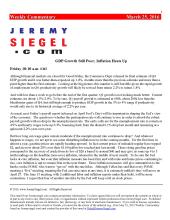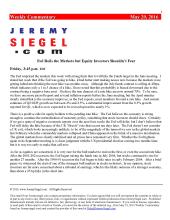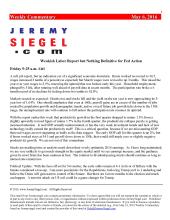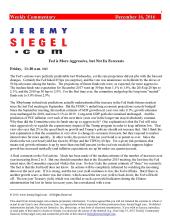In Observance of Labor Day Hudock Capital Group LLC will be closing at 4:00 PM Friday, August 30th and remain closed Monday, September 2nd 2024

Letters category: Letters
Categories

Markets on Hold as Trump Era Begins
Written by Jeremy Siegel. Reprinted with permission from Jeremy Siegel. Redistribution is prohibited.

The Dow: Almost, but not Yet; Prospect for Corporate Tax Reform
Written by Jeremy Siegel. Reprinted with permission from Jeremy Siegel. Redistribution is prohibited.
Reducing US Stocks to Bring Balanced Portfolios Closer to Long-Term Targets
Written by RiverFront Investment Group. Reprinted with permission from RiverFront Investment Group. Redistribution is prohibited.

Strong Labor Report; Stocks Stall as traders wait for earnings
Written by Jeremy Siegel. Reprinted with permission from Jeremy Siegel. Redistribution is prohibited.
2016: The Year in Review
Every January, it’s customary to take a look back at the year that was. What were the highlights? What were the “lowlights”? What got us to where we are today? What were the events we’ll always remember?
Most importantly, what did we learn?
To answer that, let’s briefly recap some of the most notable events of 2016. Some have to do with politics and some with the markets. We’ll even throw a little “sports talk” in. Then see if you can spot a common theme.
Early Market Volatility
Right off the bat, there were signs 2016 would be an interesting year when the Dow® got off to its worst start since 1897.1 January saw the Dow, S&P 500®, Chinese stock market, and oil prices all tumble dramatically. Analysts started talking about how 2016 would probably be a nasty year for stocks, and some even predicted it to be the beginning of a bear market. Remember that last sentence, because we’re going to come back to it in a minute.
Brexit
The markets endured a topsy-turvy month or two, but by the middle of March, they had recovered to the point that returns were positive for the year, defying many analysts’ expectations. The next few months were relatively unremarkable until summer rolled around and the world was confronted by a new word to learn: Brexit.
Here’s a quick synopsis: on Thursday, June 23, the United Kingdom held a referendum over whether to leave the European Union. In the lead up, various polls indicated a close contest, but with a slight edge to the side voting to remain in the EU. Most poll watchers expected that “remain” would indeed be the ultimate outcome. In the end, over 33 million people went to the polls, and when the dust cleared, the result took almost everyone by surprise: the UK had voted to leave.
A big change in the status quo almost always leads to economic uncertainty, and Brexit has caused a lot of uncertainty. In fact, the EU and the UK are both still trying to answer questions about how the split will occur, how much of a relationship the two entities will still have, and what this will do to their respective economies.
As you might expect, that uncertainty created angst in the global markets as well. The Dow, for example, slid over 600 points in light of the news.2 Again, it looked as if investors might have to weather a rough second half of the year.
A few weeks later, the Dow achieved its first record close since May of 2015.3
U.S. Elections
On this side of the pond, we experienced our own political surprise when Donald Trump became the 45th president of the United States.
As with Brexit, the news came as a shock to most pollsters and political analysts, who had Hillary Clinton as the favorite going into the election. Nevertheless, Trump won the Electoral College handily.
Since then, the markets have gone on a tear. Expectations that a Trump administration—and a Republican Congress—will lead to higher interest rates, lower taxes, and fewer regulations have driven a tremendous climb in all four of the major U.S. stock indexes. The Dow recently hit 19,000 for the first time, and as of this writing, is closing in on 20,000.
A far cry from when analysts warned of a possible bear market in 2016.
Sports
Let’s shift gears for a moment.
While it didn’t get much coverage over here, sporting history was made in May when Leicester City, a relatively small soccer club in England, won the Premier League championship for the first time in their 132-year history. It was a stunning accomplishment—and one nobody could have predicted.
Here in the U.S., we saw our own history made a month later when the Cleveland Cavaliers defied expectations by winning the NBA championship. It was the team’s first ever title, and the first major trophy won by a Cleveland-based team since 1964. The Cavs were also the first team to come back from a 3-1 deficit.
As exciting as that series was, it pales in comparison to what the Chicago Cubs did a few months later. Not only did they come back from their own 3-1 deficit in the MLB World Series, they also won their first championship in over a century.
So what can we learn from all this?
Have you spotted the common theme yet? If not, here it is: all of these events went contrary to most expectations. In 2016, the unexpected kept coming true.
Many analysts thought 2016 would be a bad year for the markets. We saw the opposite. Many analysts thought Brexit would never happen. It did. Many analysts thought Donald Trump would lose. He won. Even in sports, most predicted Golden State to win the NBA finals. Most figured the Cubs would fail to overcome a 3-1 deficit.
You get the picture.
The reason we point all this out isn’t to criticize the various pollsters, pundits, and prognosticators who got these events wrong. In most cases, they had good reasons for thinking the way they did. They used history, statistics, and demographics to shape their expectations. They gave educated, well-researched opinions.
And yet, they were still wrong.
So what can we learn from this? Two things:
- Expect the unexpected. Don’t assume that what seems most likely to happen is guaranteed to happen.
- For investors, planning is better than predicting.
You’ve probably heard us say both these things before, but 2016 proved them. As your financial advisors, we spend a lot of time researching the markets. Our job is not to predict what’s going to happen, but to help you plan for what could happen. That’s why, as your Wealth Partners with Purpose, we have devoted a great deal of time with you to plan well. We constantly monitor your portfolio to see how it’s measuring up to your goals and your risk tolerance. And we regularly review, and as necessary, make revisions to your portfolio to account for market conditions and changes in your goals. Together, we’ve developed a comprehensive investment strategy that takes a long-term view, which we believe is the best way to plan for the unexpected.
Consistent with this strategy, we begin each year by rebalancing your portfolio to make sure that it continues to reflect the type of diversification, and the level of risk tolerance, that corresponds to your goals. As a result, you will see a number of trades in your account this month as we implement the rebalancing for your portfolio. Should you have any questions regarding any of these trades, or the rebalancing process, please do not hesitate to contact us. The best way for us to plan for the unexpected is to continue to work together to implement your long-term investment strategy. Together, we have planned well and should look forward confidently to the year ahead.
On behalf of everyone here at Hudock Capital, have a happy New Year! Thanks again for being such a valued client. Please let us know if there’s ever anything we can do for you.
Sincerely,
Barbara B. Hudock, CIMA®, CPM®
Chief Executive Officer
Founding Partner
Michael J. Hudock, Jr., CPM®
President and Founding Partner
Wealth Consultant
Sources:
1 Matt Egan, “Dow has worst four-day start to a year on record,” CNN Money, January 7, 2016. http://money.cnn.com/2016/01/07/investing/stocks-markets-dow-china/index.html?iid=hp-stack-dom
2 Jethro Mullen, Ivana Kottasova, Patrick Gillespie, “Dow plunges over 600 points as UK earthquake crushes global markets,” CNN Money, June 24, 2016. http://money.cnn.com/2016/06/23/investing/eu-referendum-markets/index.html?iid=EL
3 “2016 The Year in Review,” The Wall Street Journal, December 2016. http://www.wsj.com/graphics/year-in-review-2016/
Investment advisory services are offered through Hudock Capital Group, LLC, an SEC Registered Investment Advisor. Securities offered through representatives of Comprehensive Asset Management and Servicing, Inc. (“CAMAS”), 2001 Rte. 46, Parsippany, NJ, 07054, member FINRA/SIPC (800-637-3211).
Hudock Capital Group is independent of CAMAS. (01/17)
Outlook 2017 Highlights: Passing the Baton
Written by RiverFront Investment Group. Reprinted with permission from RiverFront Investment Group. Redistribution is prohibited.

Reflections on 2016: Don’t Follow the Crowd!
Written by Jeremy Siegel. Reprinted with permission from Jeremy Siegel. Redistribution is prohibited.

Dow Struggles to Top 20,000; No Clear Direction for Holiday Week
Written by Jeremy Siegel. Reprinted with permission from Jeremy Siegel. Redistribution is prohibited.
US Stocks – A Bit Stretched, But New Highs Confirm Bull Market
Written by RiverFront Investment Group. Reprinted with permission from RiverFront Investment Group. Redistribution is prohibited.

Fed is More Aggressive, but Not Its Forecasts
Written by Jeremy Siegel. Reprinted with permission from Jeremy Siegel. Redistribution is prohibited.
